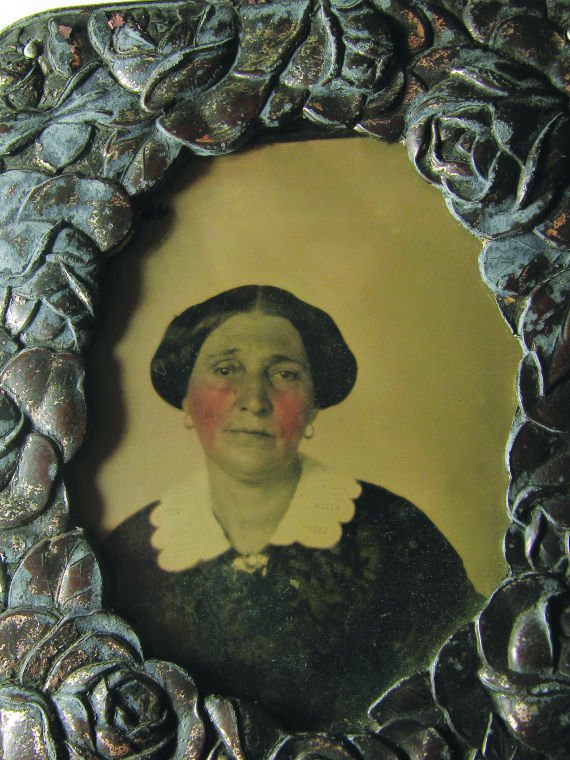
The woman staring out at me was not smiling. She had not seen the light of day in many years but had been kept safely hidden away, thanks to grandma’s packrat tendencies, love of genealogy and appreciation for her New England roots. I rediscovered the photo last week in a box that had not been opened since 1970, when my grandma passed away.
I couldn’t tell how old the woman in the picture might be; she was no spring chicken, but her hair was still completely dark with no sign of gray. All I had to go on was her name, Eunice Bryant Babb, written on the back of an antique eyeglasses case in which my grandmother (also named Eunice) had stored the photo. The photo itself is only two inches across and rather dark; I could not make out any detail.
I took it to my friend Howard Hall for help. He is an expert at using various photo enhancement techniques. He told me that this image is called an ambrotype, a photo imprinted on glass. There are two sheets of very thin glass glued together with the image sandwiched between them. It has a metal plate behind the glass that is painted black and creates the positive image on the glass. If you remove the black metal plate from the back, the image looks more like a negative and almost completely disappears.
Eunice’s cheeks are hand-painted onto the glass to give a hint of color. Hand-colored cheeks or lips made the photo more expensive, thus possibly indicating a “person of substance,” according to some photography buffs.
I wanted a date for the photo, and I found that in this time period, it is the hairstyle that is the best indicator. Eunice’s hair is worn in the style that was the height of fashion in the 1850s, which was always parted in the middle and pulled back on either side in wings. During the early 1850s, these wings were extreme rolls that extended out above the ears. Around the mid-1850s, the rolls in the hair begin to soften and transition into padded wings over the ears. In 1857, the hair, still parted over the middle and pinned up in the back, always covered the ears in thick pads or rolls.**
Also, it turns out that this two-glass plate style of ambrotype was only made in America between 1855 and 1857, so adding that to the fashion information allows for a fairly accurate estimate that the photo was most likely made in 1855 when Eunice was 56 years old.
I am building an online family tree, so now I can scan this photo in to share with other descendants on the website for the first time, as they share theirs with me. Anyone can copy the photo to their page with one click of a button.
On Ancestry.com, I was also able to determine that Eunice’s father, Stephen Bryant, was a Patriot soldier in 1776 in the American Revolution at age 17.
My grandmother always insisted that we were related to someone on the Mayflower, as well as related to a famous American romantic poet, journalist, and longtime editor of the New York Evening Post by the name of William Cullen Bryant (11/3/1794 – 6/12/1878). I was determined to check out the family rumors.
After many hours of research, I discovered that the woman in the picture was indeed the third cousin of William Cullen Bryant, giving me a distant family connection by making me Bryant’s third cousin five times removed. In other words, had I lived five generations ago, our great-grandparents would have been siblings, and we would have shared the very same great-great-grandparents.
Thanks to William Bryant’s family tree having already been well-researched by genealogical experts, the online information indicated that he was descended from Myles Standish, a passenger on the Mayflower. Once you connect your family line with anyone well-researched (either for being famous or infamous), it is a great shortcut; you can quickly tie into their tree.
My heart was pounding as if I were watching a suspense movie as I traced my generations in relation to William Bryant’s and finally reached the point where my hand hovered over the final mouse click that would link Eunice’s family tree to Myles Standish. At that moment, it was so exciting to officially add Standish to my tree as one of my 9th great-grandfathers, all thanks to the picture saved by my grandmother.
She would love being proved right, and she would love that the image of her namesake has new life, and that now other descendants around the world can access her picture and add it to their own family trees. Eunice Bryant Babb lives on!
Details:
-To see these hairstyles, visit www.uvm.edu/landscape/dating/clothing_and_hair/1850s_hair_women.php
-For women’s fashion since the 1850s, decade by decade, go to: www.uvm.edu/landscape/dating/clothing_and_hair/index.php












